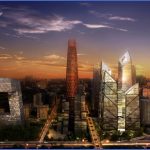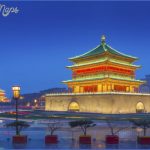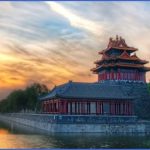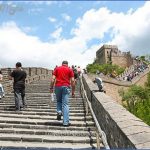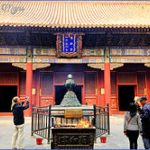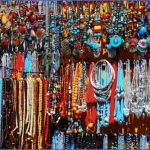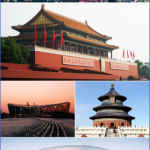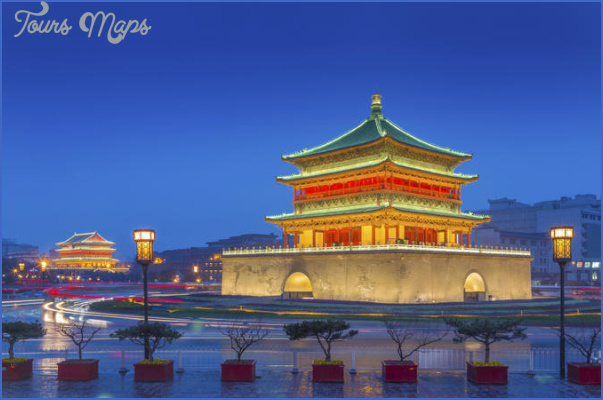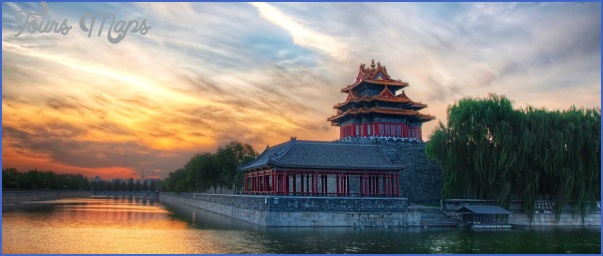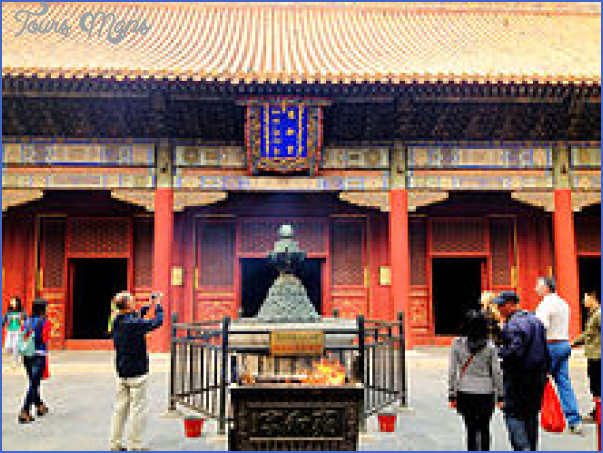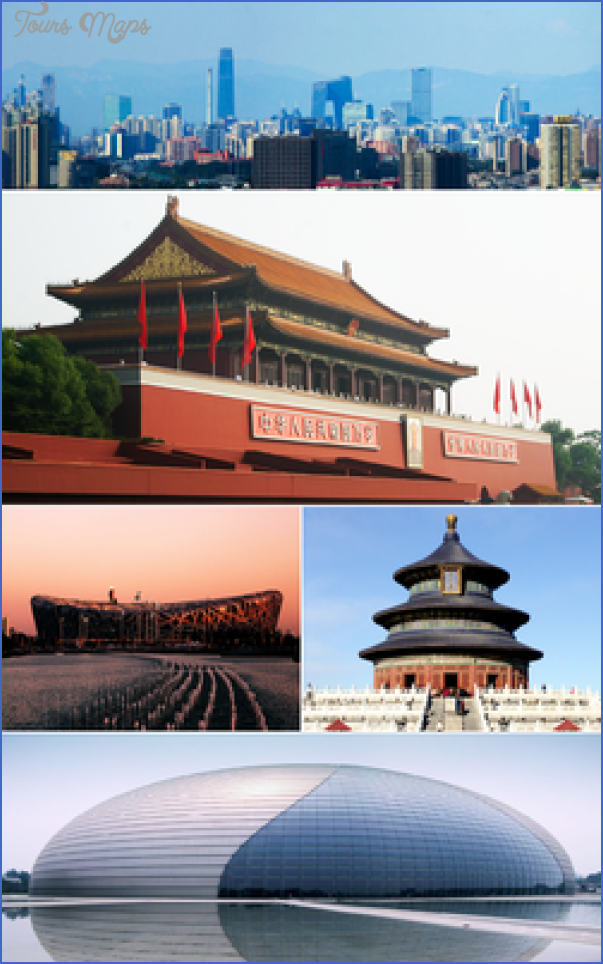Beijing Peking present day name Beijing (“northern capital”). The majority of today’s existing buildings and the layout of the city (see below) date from this dynasty.
In 1644 Li Zicheng, the leader of a peasant uprising occupied Beijing, but it was soon taken over by the Manchurians. From the middle ofthe 19th c. Beijing was the scene of conflict between the empire and foreign powers. English and French troops destroyed the old summer palace. The government was forced to grant the colonial powers their extra-territorial rights and allow them to establish permanent embassies. During the so-called Boxer uprising revolutionaries occupied the embassy quarter, but were soon forced to surrender to the foreign troops. Following the collapse of the Qing dynasty in 1911 Beijing became capital ofthe new republic. When the Treaty of Versailles stipulated that the former German possessions were to be given to Japan there were demonstrations here on May 4th 1919. As Nanking was the capital between 1928 and 1949 the name ofthe city was changed again; the nationalists decided to resurrect the old name of Beiping. From 1937 to 1945 the city was under Japanese occupation. On the October 1st 1949 Mao Zedong proclaimed the founding ofthe People’s Republic of China and choose the city as capital again under the name of Beijing, which to this day represents the political centre of the republic. In June 1989 the People’s Liberation Army violently suppressed a peaceful demonstration which was staged predominantly by students.
The historic city centre which dates from the Ming dynasty (14th17th c.) has largely preserved its original appearance. Traces of the medieval city which was divided into two parts can still be seen. It joined the four points ofthe compass and consisted ofthe north city formerly known as the Tartar city which was laid out on a regular rectangular pattern. This section was defended by a 20km/12 mile long wall with nine gates (two in the east, three in the south, and two in the west and north sides). The south city was surrounded by a 14km/9 mile city wall with seven gates.
The two city walls were completely destroyed, but two of the old gates are preserved – the “Qian Men” behind Mao’s Mausoleum and the “Des-heng Men” in the north of the forbidden city.
After 1949 a permanent change in the appearance ofthe city took place. Owing to a redevelopment programme the majority of the city walls and numerous old houses were demolished. Wide streets, various public buildings such as museums, sport centres, airports, etc. emerged in their place and the underground, which runs underthe line of the former city wall, was built. Since the late 1970s an endless succession of unimaginative, monotonous skyscrapers have been built as well as tenement blocks to house the evergrowing population, hotels, administrative buildings, etc.
From the mid-eighties the government has tried to carry out the redevelopment of the old city more cautiously; this plan also includes restoring cultural and historic relics. It is intended that usage of space will be reduced and that the ecological problems will be solved.
From the point of view of the tourist, Beijing is China’s most interesting city. Among the city’s historical and cultural monuments are the Imperial Palace, the Beihai Park, the Coal Flill Park and the Heavenly Temple.
On the city’s outskirts there are many other sights, including the Summer Palace, the Fragrant Mountain, the Great Wall, and the Ming Tombs.
Industry, which has only developed to any great extent since 1949, consists predominantly of iron and steel production, engineering and the construction of heavy goods vehicles, locomotives and goods wagons, also petro-chemical industry (including an oil refinery with a pipeline from Daqing). Light industry includes electrotechnics and electronics, textiles (especially cotton-processing), printing and food industry. Besides this is a substantial cottage industry producing handmade wares including porcelain, ivory and jade carvings, lacquer ware, cloisonne, copper tableware, carpets, embroidery and lacemaking.
The City The Economy
In the surrounding regions agricultural production includes vegetable and fruit growing, cotton and peanut farming, and breeding small animals (especially ducks).
As the capital, Beijing is also the main junction for the network of roads and railways, and has the largest international airport in the country. In 1996 the new West Station was opened which, with an area of some 500,000sq.m/ 5% million sq.ft, is the largest railway station in Asia. Tong Xian, east of the city, is the northern end of the Emperor Canal. There is an underground train service in the inner city, which serves all the main places of importance.
Beijing has an enormous traffic problem, the roads hardly being able cope with the volume of traffic.
Key sights in the City Centre
The Square of Heavenly Peace, situated in the city centre, measures about (500x800m/547x875yd). Up to a million people could fit into this square, making it probably the largest square in the world. It forms not only the geographical, but also the historical core of the city. The square was laid out in 1651, but was considerably enlarged in 1958. During the 20th c. important political events have taken place here. On May 4th 1919 students demonstrated against the Chinese provisions of the Versaille treaty. Following the memorial day of April 4th 1976 countless Beijing residents mourned their popular prime minister Zhou Enlai, and a demonstration against the Jiang Qing group ensued, which was forcefully suppressed. In the early summer of 1989 demonstrations for democracy and against press censorship took place here and these were also brutally suppressed. The west ofthe square is bordered by the colossal Great Hall ofthe People, the east by a further monumental building which houses the Museums of Chinese History and Chinese Revolution. The Chairman Mao Mausoleum lies to the south, and in the centre of the square is the Monument to the People’s Republic.
The Gate of Heavenly Peace (open: 9am-4.30pm), which was completed in 1417 and restored in 1651, once formed the main entrance to the Imperial Palace. The 34m/111ft high wooden building stands on a red brick substructure (over 10m/33ft high) which has a white marble base. The two-storey roof is covered with ceramic tiles. In front ofthe gate stand two stone lions, and two columns topped with the mythical creature Kong. A portrait of Chairman Mao hangs over the portal, to its left is the slogan “Long live the People’s Republic of China”, and to the right “Long live the unity ofthe people of the world.
The imperial decrees were once announced here and received by the dignitaries kneeling. Also from here Chairman Mao proclaimed the People’s Republic on October 1st 1949.
Atthe foot ofthe gate the seven Golden Water Bridges of white marble with sculptured sides cross the stream which bears the same name.
The west side of the Square of Heavenly Peace is dominated by the monumental Great Hall of the People (built 1959; open: 8.30am-3pm), which occupies a total area of 171,800sq.m/205,472sq.yd. The 76m/249ft wide, 60m/197ft long main hall can accommodate overten thousand people. The building also has a large banquet hall with more than 5000 places and 30 rooms, one for each province, autonomous region and city, each laid out in the style of the region. Held here are the conferences of the national People’s Congress, and other most important political conferences.
The Museum of Chinese History (open: 8.30am-5pm; no admittance after 3.30pm), was built in 1959 and occupies an area of 8000sq.m/9568sq.yd. It is housed in the right wing of the massive column embellished building (officially opened 1961). It forms the boundary for the east side of the square and was closed for many years. The 9000 exhibits illustrate matters concerning the Chinese Marxist historiography of the various stages of development of Chinese development, from prehistoric times through the slave age society (2100-475 b.c.), and the feudal society (475 b.c.-a.d. 1840) to the semi-colonial, quasi-feudaldal society. They include archeological finds and reproductions of discoveries such as that of papers. The museum serves predominantly didactic purposes.
The museum of the Chinese Revolution, also established in 1959, was closed during the cultural revolution and the subsequent years. It is housed in the left wing ofthe building and extends over two storeys, each with an area of 4000sq.m/43,056sq.ft. The exhibits in this museum illustrate the most important stages ofthe Chinese revolution from 1919, and the development of the Communist Party of China.
The Monument to the Heroes Republic is a 38m/124ft high obelisk, the foundations of which were laid on the September 30th 1949. It was officially unveiled on the May 1st 1958. The monument rises from a two-tier platform and consists of 17,000 pieces of granite and marble. The north side is adorned with an inscription by Chairman Mao, which reads: “Eternal praise be to the heroes ofthe people”. On the south side is a dedication by the deceased prime minister Zhou Enlai to martyrs ofthe revolution who gave their lives in the various wars after 1840.
On the base, the ten bas-reliefs with a total of 170 figures represent (from the east to the north side) the most important events of the Chinese revolution: the opium burning in Humen, the uprising in Jintian, the rebellion in Wuchang, the movement of May 4th 1919, the movement of May
Beijing Peking Imperial Palace 30th 1925, the uprising in Nanchang, the guerrilla war against Japan, and the crossing of the Changjiang.
The rectangularChairman Mao Mausoleum is33m/108ft high and occupies an area of 20,OOOsq.m/23,920sq.yd. It is supported by 44 granite columns, dates from 1977, and lies in the south of Tian’An Men square. The inscription “Chairman Mao Mausoleum” above the entrance was calli-graphed by Hua Guofeng.
In the entrance hall stands a marble statue of Chairman Mao, with a landscape background painting by the artist Huang Yongyu. In the central hall lies the body of Mao in a crystal sarcophagus. On the back wall can be seen an engraved homage to the “great chairman” which reads: “eternal praise be to chairman Mao, our great leader and master”.
Beijing Photo Gallery
Maybe You Like Them Too
- The Best Cities To Visit in The World
- World’s 10 Best Places To Visit
- Coolest Countries in the World to Visit
- Travel to Santorini, Greece
- Map of Barbados – Holiday in Barbados

